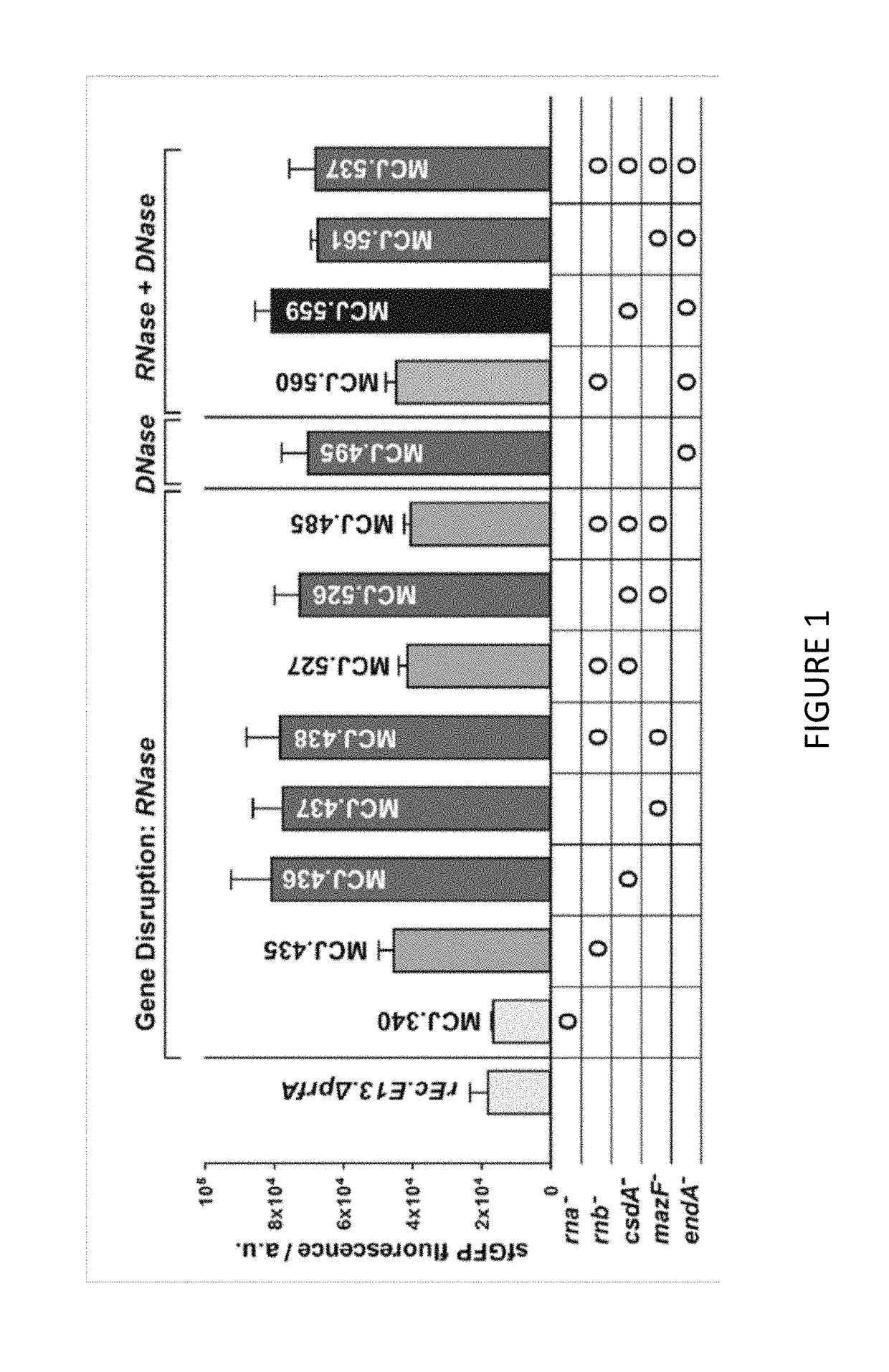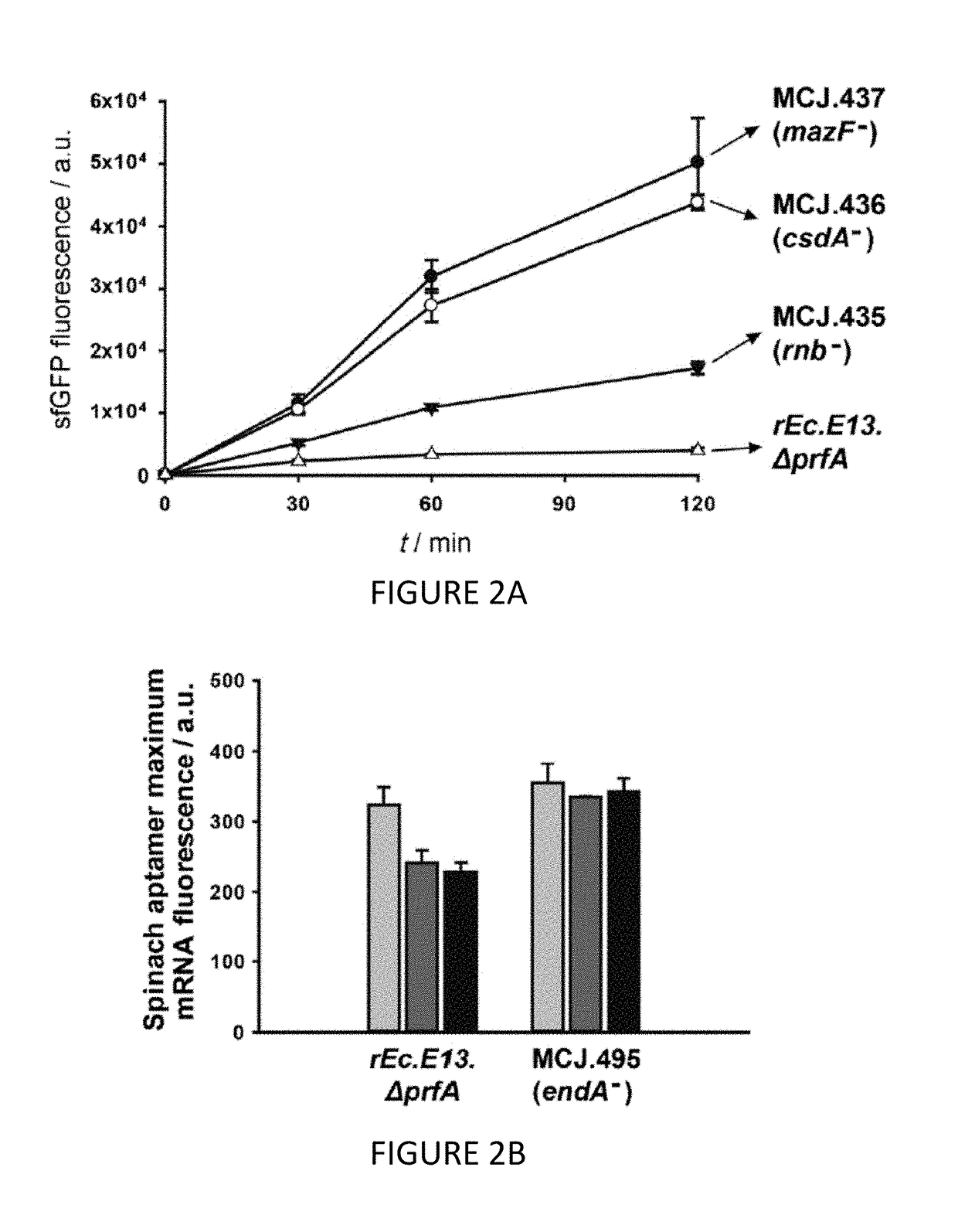Platforms for cell-free protein synthesis comprising extracts from genomically recoded E. coli strains having genetic knock-out mutations in release factor 1 (RF-1) and endA
a technology of cell-free protein and platform, which is applied in the field of platform for cell-free protein synthesis comprising extracts, can solve the problems of limited efficiency of amber suppression technology for nsaa incorporation, and the critical challenge of high-yield protein production with multiple-site incorporation of nsaas, so as to improve chaperone levels or translation functions
- Summary
- Abstract
- Description
- Claims
- Application Information
AI Technical Summary
Benefits of technology
Problems solved by technology
Method used
Image
Examples
example 1
Methods of Making and Using RF1 Deficient rEc.E13.ΔprfA Strains for the Preparation of Proteins and Sequence-defined Biopolymers
[0110]We engineered the rEc.E13.ΔprfA strain by disrupting the Rnase genes, both individually and in combinations, using MAGE. Specifically, we used MAGE oligos to introduce an internal stop signal (TAA codon) and frame shift mutation ˜1-4 into the open reading frame of the target gene (TABLE 2). We generated single disruptions of ma, rnb, csdA, and mazF, as well as multiple disruptions of rnb, csdA, and mazF, in different combinations to create a series of Rnase mutants (TABLE 3). Gene disruptions were screened by multiplex allele-specific PCR that amplified PCR bands specific to each mutation and confirmed by DNA sequencing. We then measured growth rates for each of the MAGE-modified strains in 2×YTPG media (the medium used in preparation of cell lysates) to determine how the gene disruptions might affect cellular fitness. Growth rates of the strains with...
example 2
Methods of Making and Using RF1 Deficient C321.ΔA Strains for the Preparation of Proteins and Sequence-defined Biopolymers
[0140]The genomically recoded organism, C321.ΔA, has been utilized for the synthesis of proteins with NSAAs and is ideal for multi-site incorporation due to the lack of RF1. In efforts to utilize this strain for cell-free synthesis of proteins containing NSAAs, we first wanted to gauge the maximal production of protein in a standard cell-free environment. The activity of lysate generated from C321.ΔA was compared in a time course expression test alongside the current cell-free, state-of-the-art expression system derived from BL21 Star™ (DE3) (FIG. 7). Reactions were run for 24 h at 30° C. in batch mode. Not surprisingly, C321.ΔA protein yields were 3.2-fold lower at 24 h likely because protein expression had not been previously optimized for CFPS.
[0141]To improve the CFPS yields of C321.ΔA, we sought a genomic engineering approach to eliminate putative negative e...
example 3
Methods of Making and Using and Using RF1 Deficient C321.ΔA Strains for the Preparation of Proteins and Sequence-defined Biopolymers Incorporating Pyrrolysine-based NSAAs
[0174]We tested the incorporation of two NSAAs: 1) N6-(5-Norbornen-2-yloxycarbonyl)-L-Lysine Hydrochloride hereafter referred to as Pyrrolysine Norbornene and 2) N6-(propargyloxycarbonyl)-L-Lysine Hydrochloride hereafter referred to as Propargyl Carbamate. Leveraging the open nature of the cell-free system, we first optimized the expression of modified proteins (i.e., those containing NSAA) by adjusting the composition of purified cell-free components (e.g., tRNAcuAPyl, PylRS, etc.). We did so in two different strains, with and without RF1. Second, we assessed the impact of PylRS and tRNAcuAPyl in the extract during source strain generation rather than adding them as purified exogenous components. Third, we directly compared the results from the CFPS system to those from cells. The resulting CFPS platform synthesize...
PUM
| Property | Measurement | Unit |
|---|---|---|
| temperature | aaaaa | aaaaa |
| temperature | aaaaa | aaaaa |
| temperature | aaaaa | aaaaa |
Abstract
Description
Claims
Application Information
 Login to View More
Login to View More - R&D
- Intellectual Property
- Life Sciences
- Materials
- Tech Scout
- Unparalleled Data Quality
- Higher Quality Content
- 60% Fewer Hallucinations
Browse by: Latest US Patents, China's latest patents, Technical Efficacy Thesaurus, Application Domain, Technology Topic, Popular Technical Reports.
© 2025 PatSnap. All rights reserved.Legal|Privacy policy|Modern Slavery Act Transparency Statement|Sitemap|About US| Contact US: help@patsnap.com



